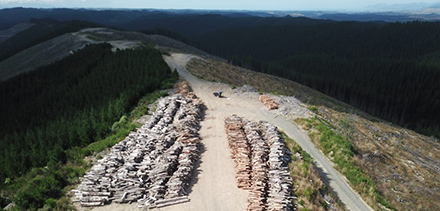Cyclone Gabrielle devastated Napier and the East Coast. Here, slash builds along the washed out Redclyffe Bridge over the Tutaekuri River at Waiohiki as the region prepared for more heavy rainfall.
Forest canopy and tree roots protect the region’s soft soils from wind and rain, which reduces erosion and sedimentation.
Flood risk is also reduced because trees capture and divert rainwater, which regulates the volume and speed of floodwaters.
These aren’t private benefits, either. They benefit people and ecosystems throughout the catchment – ki uta ki tai – from the mountains to the sea.
In that sense, forests are like public infrastructure: they produce public goods, including climate adaptation.
Yet forests are typically treated as commercial assets, as private investments into future yields of timber or carbon.
This points to a real issue: namely, the relatively slow growth rates of native tree species in their early years. Timber and carbon yields are significantly delayed for native forests, well beyond the remit of most investors.
By contrast, the precocious Pinus radiata, whether planted for clear-fell harvest or unharvested for carbon farming, delivers dependable returns over a thirty-year timeframe. For profit-seeking investors and cash-strapped landowners, the opportunity cost of native tree species is too great.
Yet isn’t this an overly constricted way of thinking about native afforestation?
We spend billions each year on infrastructure, including stop banks and seawalls, and we don’t expect these assets to pay for themselves by generating liquid cash flow.
Instead, we think about infrastructure in terms of the intergenerational balance sheet. An investment in infrastructure today, paid for by tax revenue or debt, is justified by the economic activity it enables overtime, and the losses and damages it averts for future taxpayers.
On this view, Pinus radiata is the wrong point of comparison. Instead, we should compare the costs of native forest establishment with the total avoided losses and damages to public, private and Māori-owned assets.
It’s the avoided costs of fixing farms and fences after floods and forestry debris sweeps through.
It’s the avoided losses to fisheries from silt and sediment impacts, and submerged logs wrecking boats and fishing gear.
It’s the reduced risk to infrastructure and utilities, and the avoided disruptions to economic productivity for communities whose livelihoods rely on them.
And above all it’s the avoided deaths and injuries to people who face the downstream impacts of historical land clearances, which not only undermined catchment resilience but also contributed hundreds of millions of tonnes of carbon dioxide into the atmosphere.
If new forests – whether exotic or native – can mitigate these risks, then they’re likely a bloody good deal.
To reap the full benefits, such forests will need to remain unharvested, or only selectively harvested. But the foregone timber revenue must be balanced with the greater avoided costs.
Also, native forests have the added benefit of recreating natural habitat, which can replenish the unique biodiversity of Aotearoa. By restoring the temperate rainforests of Tairāwhiti, by recloaking the whenua, there is a priceless opportunity for ecological and social reparations.
So how do we practically achieve this? If forests are a kind of natural infrastructure, who are the construction workers?
Instead of hard hats and high-vis jackets, it’s more likely to be camo, traps and fencing equipment. Because pest and predator control is the cheapest way to convert pastoral land to natural forest. If seed sources are nearby, then natural regeneration will take over, potentially amplified by enrichment planting.
For other sites, once browsing pests are under control and native nurseries are achieving economies of scale, then hand planting will be more cost-effective.
This shouldn’t be left entirely to volunteers or time-poor farmers. As a nation, we should be willing to pay for this workforce no less than we pay people to build roads and tunnels. Nature-based solutions, like forests and wetlands, are critical infrastructure in the Anthropocene.
The Jobs for Nature programme, which ends next year, had a positive impact on regional communities through Aotearoa. How might we improve such a programme for future-proofing the East Coast?
Instead of recovery funding only going to replace roads and bridges, a portion might be allocated to natural infrastructure that reduces the risk of future washouts. If general funds are unavailable, this could be funded by a sovereign green bond, which earmarks bond proceeds for resilience-enhancing projects that reduce the forward liabilities of the Crown. Over the long run, the government could dust off the Tax Working Group’s recommendations for a levy on intensive land uses, with the revenue recycled into nature-based solutions.
Cyclone Gabrielle was a shocking reminder of how exposed the East Coast is to climate-related events. But delivering a nature-based recovery might precipitate a shift in mindset that benefits us all.
David Hall is the Climate Policy Director at Toha (NZ).






